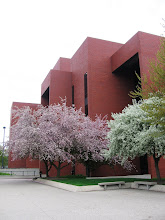
The Small Cities Conference, titled “The Small City in a Global Context” was held at Ball State University beginning Thursday, April 12 through Saturday, April 14, 2007. The well-attended event was sponsored by The Center for Middletown Studies and co-sponsored by the Urban History Association, Ball State University Libraries, and the Ball State Mu Beta Chapter of Phi Alpha Theta History Honorary Society.
The conference attracted attendees from across the nation and from other countries, in addition to Ball State students, faculty, and Muncie area community persons.
The Welcome Session, Digital History and the Small City: The Plains Gilded Age City Digital Project, was held at Bracken Library in the Forum Room, attended by over 70 students, faculty, and community members. Open to the public, the speaker was Dr. Timothy Mahoney, Department of History, University of Nebraska. The session moderator was History Department chair E. Bruce Geelhoed.
Professor Mahoney’s areas of specialization are 19th century United States social and urban history. He is also interested in local and regional history with an emphasis on the early Midwest including Nebraska, gender history, comparative history of the middle class, and historiography.
The Center for Middletown Studies’ mission is to build on the research and scholarship inaugurated by Robert S. and Helen Merrell Lynd, in their landmark studies Middletown (1929) and Middletown in Transition (1937). Between 1924 and 1937, the Lynds led a team of researchers investigating life in Muncie, Indiana. The two books became classic sociological studies and they identified Muncie as a barometer of social trends in the United States.
In the years since, scholars in a variety of fields have returned to Muncie to follow up on the Lynds' work, making this small city perhaps the most studied community in the nation.
The University Libraries’ Archives and Special Collections preserves and provides access to the Middletown Studies Collection, which includes publications, surveys, photographs, oral histories, and other documentation on Muncie as “Middletown.” The Middletown Digital Archives consisting of thousands of photographs and other research resources and the newly created Middletown Digital Oral History Collection are available in the Ball State Digital Media Repository, a project of the University Libraries.
The Center for Middletown Studies sponsors and promotes research on Muncie as Middletown and on the themes and issues the Lynds explored. For more information, visit www.bsu.edu/middletown.
This newsletter article first appeared in The Library Insider 5(5): 9; May 2007.
Labels: Ball State University Libraries, Bruce Geelhoed, Middletown Studies, newsletter, Robert and Helen Lynd, small cities conference












